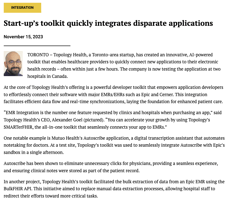Integrating software with Electronic Health Records (EHR) has become a cornerstone for providing...
Digitizing Clinical Guidelines: A FHIR North Webinar Recap
Hey everyone,
I'm thrilled to share the exciting details of a recent webinar that Azabelle Tale from Mohawk College and I co-hosted. This webinar delved into our collaborative efforts in digitizing clinical practice guidelines, focusing on the revolutionary impact of digital innovation in clinical practice and the valuable integration of FHIR.
Introducing Myself
Joining me in this insightful discussion was Azabelle Tale, an integral part of the Medic team at Mohawk College, where she passionately works on bridging the realms of healthcare and technology to advance medical solutions.
Unveiling the Project
We took the audience on a journey through the project, beginning with an introduction to Medic's role in digital health innovation. This collaborative venture with Topology Health aimed to develop a FHIR-enabled application for testing Clinical Practice Guidelines.
Addressing the Challenges
I delved into the challenges that clinicians face with the current distribution of Clinical Practice Guidelines in static formats like PDFs. Our project sought to address these challenges by transforming guidelines into a more accessible and computable format.
Demonstrating the Application
Azabelle walked us through the application, showcasing its user-friendly interface designed to simplify the digitization process. Our goal was to empower clinicians by providing them with a tool that translates complex guidelines into actionable recommendations without requiring extensive software development expertise.
Leveraging FHIR Integration
I highlighted the crucial role of FHIR integration in streamlining the guideline creation and application process. This integration, based on HL7 standards, not only enhances interoperability but also facilitates seamless interaction with Electronic Medical Records (EMRs).
Unveiling the Guideline Testing Tool
Azabelle provided an in-depth look at the Guideline Testing Tool, a critical component of our project. This tool visualizes guidelines as decision trees, allowing authors to validate the logic and accuracy of their guidelines. Testing with synthetic patient data ensures that guidelines function as intended in real-world scenarios.
Embracing Open Source
In a significant move, I announced our decision to make the platform open source. By doing so, we aim to invite contributions from the global community, fostering collaboration and improvement. The open-source nature of the platform allows for diverse perspectives, leading to a more refined and polished product.
What Lies Ahead?
As we pause the guidelines application for now, our focus shifts to EMR integration. I shared insights into the barriers we encountered and the ongoing efforts to simplify the integration process. The team is committed to providing a platform that empowers web developers and health tech enthusiasts to seamlessly integrate with EMRs.
A Pledge to Continuous Improvement
Closing the webinar, we reiterated our commitment to improving healthcare through digital tools. Our collaboration with Mohawk College and Medic has been a testament to the transformative potential of digitizing clinical practice guidelines. By making our platform open source, we hope to catalyze positive change in healthcare practices worldwide.
Final Thoughts
The webinar was an enriching experience, and I appreciate the engagement and thoughtful questions from the audience. If you missed the live session or have additional questions, feel free to reach out. I look forward to a future shaped by innovation, collaboration, and the continuous pursuit of better healthcare solutions.
Thank you for being part of this journey.
Josh Liben
Chief Technology Officer
Topology Health
Link to the Open Source Project: [LINK COMING SOON]
Link to watch the recorded Webinar:

